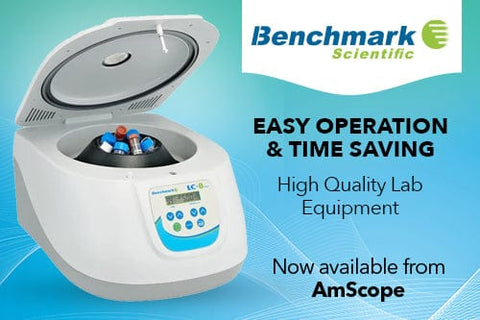HOW TO CHOOSE A MICROSCOPE: TYPES & COMPARISONS | AMSCOPE
How to Choose a Microscope
Your application (what kind of samples/objects you intend to view) is the most important factor in choosing a microscope. What you need to see and what you want to do with that image will determine what kind of microscope you need; contrary to common knowledge, there are many different types of microscopes, and no single microscope can view everything. Much like any industry, the key for success with microscopy is having the right tool for the job at hand.
When you’ve learned what type of microscope is appropriate for your application, please feel free to use the navigation bar at the top and our filter-based sorting system to narrow down our many options to specifically what you are looking for. As a bonus, if you see something that catches your eye here, we’ve provided several convenient links to take you directly to similar products, so feel free to click around!
Table of Contents
Compound vs. Stereo
There are two basic types of optical light microscopes: compound (high power) and stereo (low power). Consider what you can see with each microscope.

AmScope B490 Compound Microscope
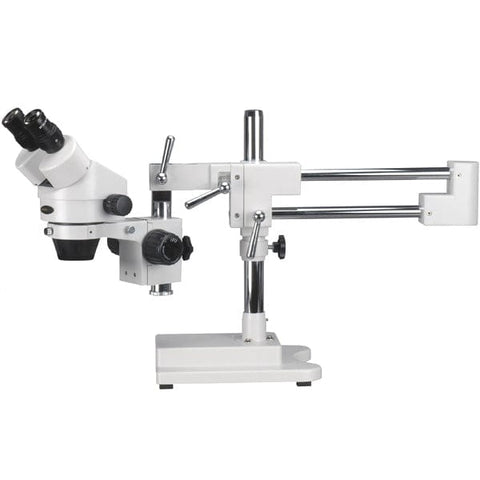
AmScope SM-4T Stereo Microscope
If you need very high magnification to view the internal structures of cells, you would most likely use a compound microscope. Compound microscopes have not only very high magnification settings, but also have very high optical resolution (meaning, you can visualize very small features in an image with the objective lenses that come with these microscopes).
Here is an example of what you would expect to see with a compound microscope:
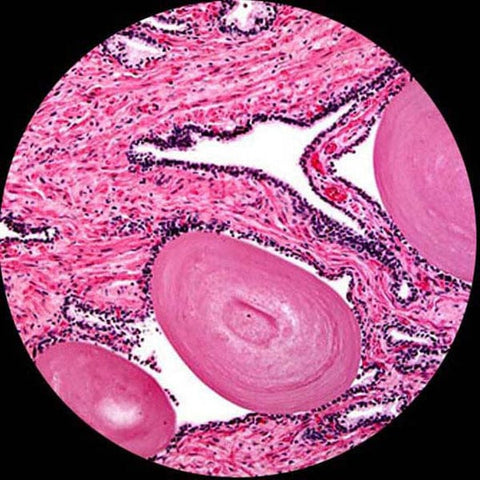
Compound Microscope Field of View
If you need to examine solder joints on circuit boards or other relatively large objects, you would probably use a stereo microscope. Stereo microscopes have relatively low magnification settings, but also have larger focusing distances, so you can fit hands and tools between the lens and the sample. They also have larger fields of view, so you can see a larger area of a sample under the microscope. Here is an example of what you would expect to see while using a stereo microscope:
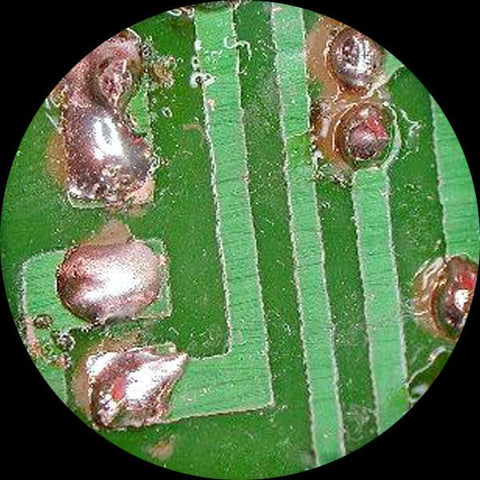
Stereo Microscope Field of View
Monocular, Binocular, and Trinocular Microscopes
An important thing to consider when choosing a microscope is its head type. Monocular, binocular, and trinocular head types are designed differently and suited for particular types of observations.
Monocular Microscopes
Monocular microscopes have a single tube that houses an eyepiece at one end and an objective lens at the other. The design means that specimens will appear flat and without depth when you look in the eyepiece. Monocular microscopes are easy to use and ideal for classrooms or as a home microscope for kids and teens.
Binocular Microscopes
Binocular microscopes have two tubes and eyepieces, and this can make it more comfortable to examine specimens. Binocular head pieces can be used in educational, research, and commercial settings.
Trinocular Microscopes
Trinocular microscopes are similar to binocular ones except that they have an extra port for attaching a camera and taking photographs or videos. This makes the trinocular head type ideal for educators or researchers.
Which Microscope is Best for You?
Each microscope type will be further defined below in their respective section, however, a very simple way to determine what kind of microscope you need is by thinking of the sample type you want to view. Compound microscopes tend to require samples that you can pass light through to create an image, as the light comes from the bottom of the microscope up through the sample (transmitted illumination). Stereo microscopes, on the other hand, tend to work best with samples that you cannot pass light through, as they have upper light sources (reflected illumination) to shine down and bounce off of those samples to create an image.
As an example, you wouldn’t want to use a compound microscope with a transmitted light if you wanted to view a coin. A coin cannot pass light through it, so, you would be better off with a stereo microscope with a reflected light (as well as because you want a big field of view to see the whole coin). If you used a transmitted light, you’d get a black image in your microscope, as no light can pass through the coin.
Conversely, if you wanted to view a bacterial cell, you would want to use a compound microscope with a transmitted light, because a reflected light would wash your sample out, as it does not reflect enough light to make an image (as well as because you need the higher magnification to view such small details). You would probably see a very small outline of the cell, without much detail inside, if any at all, trying to use a stereo microscope with a reflected light with a slide that had a cell sample on it.

Slides for Mounting Samples to View with a Compound Microscope
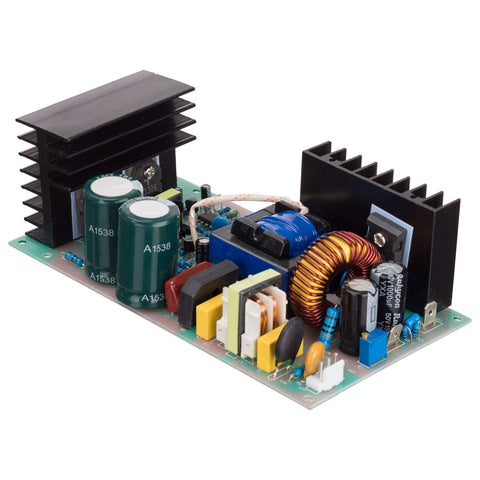
Circuit Board to View with a Stereo Microscopes
Within each of these basic microscope types, however, there can be far more demanding requirements, and a variety of advanced microscopy methods or techniques exist within each base type of microscope. There exist some compound microscopes that use reflected light to view solid objects at very high magnifications, and some stereo microscopes with transmitted lights meant to view semi-opaque/semi-translucent samples, as an example. We will go over those in more specific sections, however; if you have a very specific or unique application, you may need a highly specialized microscope or special accessories to equip with one of our products. With our wide range of microscopes and accessories, we can help you configure an instrument for almost any application.
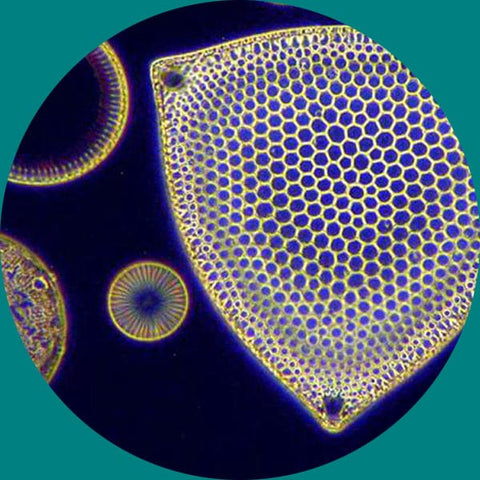
Compound Darkfield Microscopy

Fluorescence Microscopy
If unsure of what you specifically need, please don’t hesitate to contact our Customer Success team at 1-888-950-2888, toll-free! We are more than happy to apply our knowledge and years of experience in the microscopy industry to help you succeed at whatever your application is with our equipment.
Compound Microscopes
Compound microscopes are what most people visualize when they think about microscopes. They are available in monocular, binocular, and trinocular formats, which refers to the number of ocular tubes that the microscope has. We've discussed these above, but not in respect to only compound micrscopes.
Objective Turret & Objective Lenses, 4X, 10X, 40X, & 100X, SKU: T490
Many compound microscopes also have a lens underneath the stage that focuses the light from the light source through the sample and into the objective lens, called a condenser. Some have simply a disc that controls the amount of light allowed through, called a disc diaphragm, while others have a slider with an iris and adjustable positioning, and even more have a completely replaceable condenser, allowing more advanced microscopy methods to be used, such as darkfield and phase contrast.
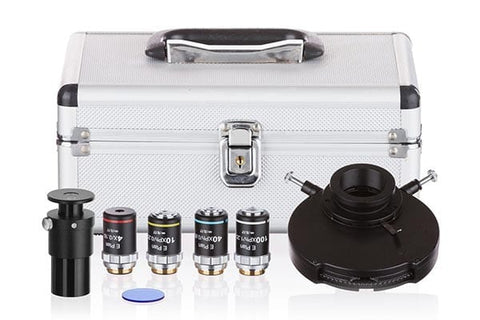
Phase Contrast Condenser Kit, SKU: PCT200-INF
If you know what you’d like to do with a compound microscope, the following table can assist in getting you started with what you’re looking for with some common suggestions, or you can use the top navigation bar to click “Applications” to browse by solution, or “Compound” to browse by microscopy type/specifications. Otherwise, you can continue on to read about the other major type of microscopes—stereo microscopes.
| Applications | Microscopy Method | Age/Education Group |
|---|---|---|
| Consumables (Food, Drink, Cosmetics) | Brightfield | K-8 (Elementary) |
| Environmental (Water/Soil) | Darkfield | 9-12 (Junior High/High School) |
| Live Blood Analysis | Phase Contrast | Undergraduate Studies |
| Medical/Clinical | EPI-Fluorescence | Graduate Studies |
| Microbiology | Metallurgical | Research/Professional Use |
| Pharmaceutical Research | Polarizing | |
| Opaque Samples/Metallurgy | Inverted | |
| Veterinary | Multi-View/Training |
Stereo Microscopes
Unlike a compound microscope that offers a 2-dimensional image, stereo microscopes give the viewer an erect (upright and un-reversed), 3-dimensional image because they use two completely independent paths of light (one to each eyepiece) that are created using objectives that are focused at slightly offset positions in relation to the sample. The name “stereo” comes from the term “stereoscopic,” meaning, using two different angles of viewing to create an impression of depth and solidity.
Because of this, true stereo microscopes only come in binocular and trinocular styles, however, a special type of stereo microscope called an “inspection” microscopes exists as well. These are very similar in nature to stereo microscopes, however, they only have a single ocular tube, so they provide a flat image view of larger, opaque objects, rather than a true stereoscopic view. We classify these here as they are capable of viewing the same sample types as stereo microscopes.
Stereo microscopes are particularly useful for biologists performing dissections, technicians repairing circuit boards, paleontologists cleaning and examining fossils, or anyone who needs to work with their hands or tools on small objects, that are large enough to be seen or handled without the aid of a high power compound microscope. Thus, stereo microscopes have a very broad set of potential applications across many industries.
There are two main subdivisions of stereo microscopes at the most basic form, based on the magnification type—fixed power & zoom power. Fixed power stereo microscopes have a set number of fixed position objectives, and offer only the magnification options listed; nothing in between. They are best for their ease of use and ease of focusing, making younger audiences and amateurs great candidates for these kinds of stereo microscopes, but they lack the flexibility of other stereo microscope types.
On the other hand, zoom power stereo microscopes have much greater flexibility because the objective lenses can be moved closer or farther from the sample within the microscope. This allows a range of magnification options to be achieved within the maximum and minimum values the microscope provides, such as 7X through 45X. They require finer levels of refocusing when changing magnification values making it a bit harder to use, but offering far greater flexibility in terms of how much working distance, magnification, and field of view can be achieved.
Most stereo microscopes are used at magnifications from 2X to 90X, but with the proper microscope and accessories, magnifications up to and approaching 180X can be achieved, or even up to 225X! This is achieved using an accessory called a Barlow lens with or without different magnification eyepieces (15X, 20X, 25X, or even 30X eyepieces) that we also offer.
What is a Barlow Lense?
A Barlow lens is an auxiliary lens that is attached to the end of a stereo microscope’s objective, which alters the magnification range (or fixed settings available) on the microscope by a multiple of the Barlow lens’ power. This can work for both increasing or decreasing the magnification, which will either decrease the field of view and working distance by magnifying the image or increase the field of view and working distance by reducing the magnification of the image, respectively.
These properties have an inverse relationship, meaning the more magnification one uses, the smaller the field of view will be, and the closer the microscope lens needs to be to the sample to focus (which means less space to use tools, called working distance or focal distance). Vice versa, the less magnification being used, the larger the field of view and working distance are. In this case, more is not always better! You want the right magnification for your sample based on your needs.
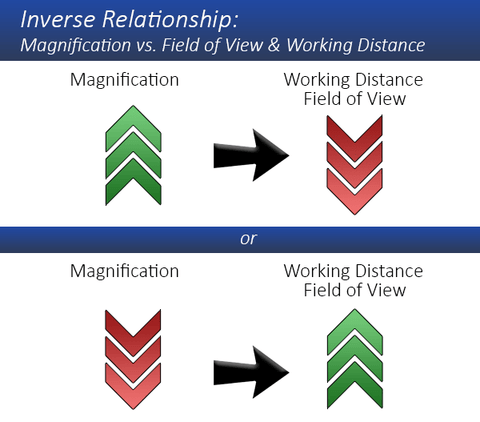
Also, this means that any SM- (7X-45X base magnification) or ZM- (6.7X-45X base magnification) series stereo microscope package can be altered by adding in any number of Barlow lenses that are offered to expand the range out. Just like compound microscopes, total magnification is a product of all magnifying elements, so a stereo microscope may have 10X eyepieces, and an objective set to 1.0X, which would give you 10X total magnification. A 2.0X Barlow lens could take that up to 20X, while a 0.5X Barlow lens could take that down to 5X, depending on which is installed (not both, as stacking will throw the focus of the objectives off, while cancelling each other out in terms of magnification modification).
The great part about stereo microscopes is that they are very modular in nature, so whether you want a pre-made package designed by us, or to customize your own setup based on your preferences, we can accommodate your needs!
Have a large sample that you need to view multiple areas of? We have a boom stand or articulating arm stand option for you. Need a simple table stand with a large area for dissection? No problem, we have that too. If you know what you’d like to do with a stereo microscope or an inspection microscope, the following table can assist in getting you started with what you’re looking for with some common suggestions. Alternatively, on the top navigation menu of the website, click “Stereo” to browse by microscopy type/specifications. Otherwise, you can continue on to read about taking an optical light microscope of either base microscope types and converting it to a digital microscope so that you can take digital images or record video by adding a camera.
| Applications | Stand | Age/Education Group |
|---|---|---|
| Art Appraisal/Restoration | Table Stand w/ Track | K-8 (Elementary) |
| Circuit Boards | Table Stand w/ Pillar | 9-12 (Junior High/High School) |
| Coins | Single Arm Boom Stand | Undergraduate Studies |
| Dissection | Double Arm Boom Stand | Graduate Studies |
| Forensics/Firearms | Ball Bearing Boom Stand | Research/Professional Use |
| Gemology/Jewelry | Articulating Arm w/ Clamp | Hobbyist Use |
| Mechanical Parts | Articulating Arm w/ Pillar & Base | |
| Watch Repair/Engraving | Inspection Style | |
| Darkfield Equipped Stands | |
If you’re unsure of what you need, or have questions about creating your own setup, give our Customer Success team a call at 1-888-950-2888, toll-free or send us an email. Our friendly and helpful agents will be happy to assist you in getting the right microscope and accessories for you.
Microphotography: Cameras & Videos
For many applications, the ability to capture, display, and preserve specimen images is of equal or greater importance than actually viewing the specimen through the eyepieces. Microphotography (35mm and other chemical formats) has been a common option on microscopes for decades, but the recent development of relatively inexpensive CCD (charged couple device) video and digital cameras has greatly increased both the popularity and flexibility of microscope imaging.
Instead of clicking through slides during a lecture, university professors can now display real-time video images on projection televisions; petroleum geologists can e-mail images of core samples to their laboratories from remote locations around the world; oncologists can refer to CD or on-line catalogues of cell images to help them make faster and more accurate diagnoses.
There are many different methods for capturing, displaying, and recording microscope images, and each has its own advantages and disadvantages. Some are USB cameras that require a computer to interface with, but, include advanced software capable of measurements and other forms of data analysis, while others are HDMI cameras with on-board storage for easy use in training or web uploading, directly to a monitor, without the need of a cumbersome PC. Others have high sensitivity to light, providing better results in low light photography, such as darkfield or fluorescent microscopy methods, whereas others are more specialized for different applications, such as with cooling systems to minimize noise for extremely high sensor performance.
It would be impossible to cover all of these options here, but one basic piece of information will be important in selecting your microscope. While it is possible to mount a camera on a monocular or binocular microscope, it is generally far better to use a trinocular microscope designed for camera work. Trinocular models have two eyepieces for normal viewing, plus a third "phototube" on which you can mount a camera without interfering with the normal operation of the microscope—many of them which have their own adjustments to help compensate for any focal differences between the eyepiece path of light and the camera’s path of light (called “simul-focal” trinocular microscopes”).
Trinocular microscopes are ideal for photo, digital or video applications.We also carry adapters for DSLR/SLR camera bodies, if you’d prefer to use your own body with a microscope—particularly useful for owners of high end cameras or professional photographers.
If you know what you’d like to do with your camera, the following table can assist in getting you started with what you’re looking for with some common suggestions, or you can use the top navigation bar to click “Cameras” to browse by camera type/specifications.
| Applications | Camera Series |
|---|---|
| General Use | MU (USB2.0/USB3.0) |
| Low Light | MA (USB2.0) |
| Wireless | HD (HDMI & On-Board Storage) |
| WF (WiFi Enabled) | |
| AF (Auto-Focus) | |
| DSLR (Adapters for DSLR/SLR Bodies) |
Depending upon your application, additional components may be required for your microscope. Our friendly Customer Succ ess team can assist you in choosing the appropriate items required by giving us a call toll-free at 1-888-950-2888 or emailing us.
Why Buy From Us?
- All of our microscopes come with a five year warranty!
- World-class Customer Success Team available via phone, email, or live chat to support you!
- Free shipping within the continental U.S!
- Best price, guaranteed!
- Flexible shopping experience -- build your own setup or one of our hand-picked bundles!









